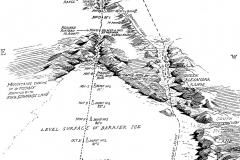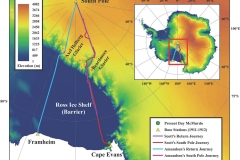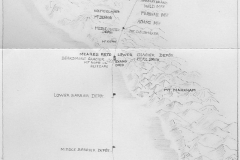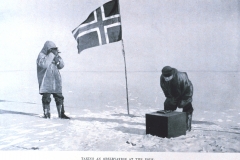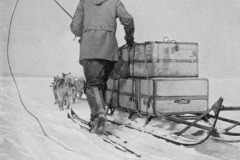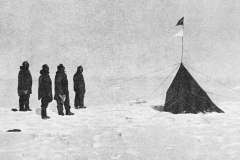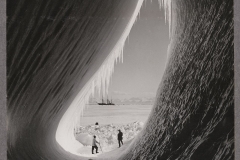Centennial E6 – A Tale of Two Journeys
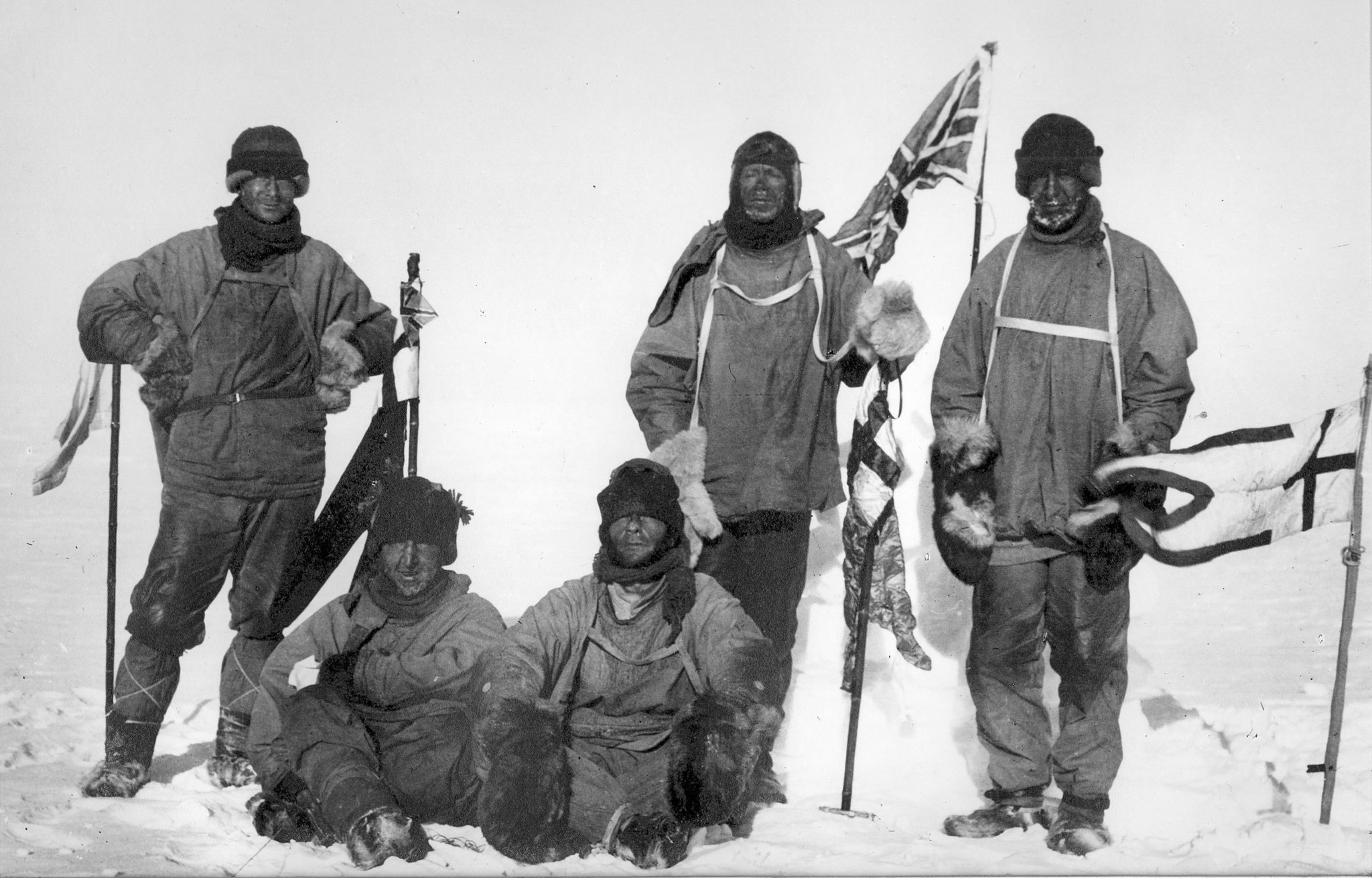
An image of Scott’s South Pole party taken on January 18, 1912. Edward Wilson, Robert Falcon Scott and Lawrence Oates are standing; Henry Bowers and Edgar Evans are sitting.
Credit: Henry Bowers; public domain.
In the early years of the 20th century, several groups of explorers attempted to be the first to reach the South Pole, as Antarctica was one of the last unexplored places on Earth. A team of Norwegian explorers led by Roald Amundsen was the first to reach the Pole on December 14, 1911. A competing British party led by Captain Robert Falcon Scott reached the Pole roughly a month later. Amundsen’s team returned safely home but Scott’s team perished on the ice in March 1912.
Recent research has suggested that Antarctica experienced unusually warm weather during the Southern Hemisphere’s summer of 1911-1912, and this weather may have influenced the outcome of Amundsen and Scott’s race to the South Pole. In this episode, Ohio University atmospheric scientist Ryan Fogt recounts the journeys of Scott and Amundsen during this fateful summer and discusses how the extraordinary weather affected the two polar parties in vastly different ways.
This episode was produced by Lauren Lipuma and mixed by Robyn Murray and Jon Schriner.
Episode Transcript
Shane Hanlon: Hello Nanci.
Nanci Bompey: Hey Shane!
Shane Hanlon: All right, so I have a question for you.
Nanci Bompey: Yep, bring it on as you usually do.
Shane Hanlon: Uh-huh, all right, if you had to choose, would you rather climb Mt. Everest or hike across Death Valley?
Nanci Bompey: Climb Mt. Everest.
Shane Hanlon: Why? You seem very sure about this.
Nanci Bompey: Okay, A, you get to the top of something, I mean, that’s impressive.
Shane Hanlon: Versus, what, getting across something, that isn’t as impressive?
Nanci Bompey: [inaudible 00:00:25]
Shane Hanlon: I wish people could see your face!
Nanci Bompey: And then, and then B – you have a Sherpa.
Shane Hanlon: Oh so-
Nanci Bompey: And oxygen, and oxygen!
Shane Hanlon: So it is not necessarily about the achievement, it is about the fact that you get to have someone help you with your achievement, who then gets no credit for your achievement?
Nanci Bompey: It’s like a walk in the park.
Shane Hanlon: It’s like a walk in the park. I think Mt. Everest too but not because I just like cold, like you can always put more clothes on than take clothes off.
Nanci Bompey: I mean, true, hot is just unbearable sometimes.
Shane Hanlon: I guess you could hire a Sherpa to take with you across Death Valley who just would fan you the entire time.
Nanci Bompey: Oh! That is something.
Shane Hanlon: Welcome to the American Geophysical Union’s podcast about the scientist and the methods behind the science. These are the stories you won’t read in a manuscript or hear in a lecture. I’m Shane Hanlon.
Nanci Bompey: And I’m Nanci Bompey.
Shane Hanlon: And this is Third Pod From the Sun: Centennial Edition.
Shane Hanlon: Okay, so I asked you about extreme conditions because today we are talking about Antarctica.
Nanci Bompey: That’s extreme, that is the coldest place on Earth, I mean the coldest place on Earth is there.
Shane Hanlon: Thank you Nanci for informing us of that. So we have our producer, Lauren Lipuma, is here to tell us more about Antarctica, Hi Lauren.
Lauren Lipuma: Hello everyone!
Shane Hanlon: As we, as we are laughing through this.
Lauren Lipuma: Yeah, so, Antarctica in the 19th century was one of, kind of, the last unexplored places in the world and people from all over Europe were leading expeditions there.
Shane Hanlon: Yeah, and there was, so it was like who, Scott, and there was, was there a Fitzgerald in there?
Nanci Bompey: No, F. Scott Fitzgerald, Shane, is an author!
Shane Hanlon: Not F. Scott Fitzgerald, Nanci-
Lauren Lipuma: There was Shackleton-
Shane Hanlon: Scott, oh Shackleton.
Lauren Lipuma: Shackleton, Mawson, I don’t remember the others though.
Shane Hanlon: Anyways, okay.
Lauren Lipuma: But yeah, Scott is one of the people we are going to talk about because he, so Robert Falcon Scott was a British explorer. He’d been in the royal navy, he was big into exploring. He led an expedition to Antarctica in 1901 that was trying to get all the way to the South Pole, but they didn’t make it that year.
Nanci Bompey: Why didn’t they make it to the south pole?
Lauren Lipuma: Well, the weather was really bad.
Shane Hanlon: Why do you think they didn’t make it?
Nanci Bompey: They just were like, ah, we are done, we are going to go home, I’m over it.
Lauren Lipuma: Yeah, they couldn’t handle the cold Nanci. They weren’t prepared, it was bad.
Nanci Bompey: Yeah, I’m sure it was terrible.
Shane Hanlon: Yeah, that’s gotta suck.
Nanci Bompey: Well, they didn’t make it that trip, but they did discover the Antarctic plateau, which is this really high cold plateau in the middle of Antarctica, that is where the South Pole is. So, they did see something though.
Shane Hanlon: Did they, so did they try to go back?
Lauren Lipuma: Yeah, so Scott went back, they went back 10 years later in 1911, but at that point he was competing with a party of Norwegian explorers led by Roald Amundsen, and Amundsen had pretty much dedicated himself to a life of exploration, and he was really determined to be the first person to ever reach the South Pole.
Lauren Lipuma: So ultimately what happened was that Amundsen and his team did reach the South Pole first. They got there in December 1911, and Scott’s team reached the pole in January 1912, but tragically he and all of his team members died on the ice.
Nanci Bompey: Oh, that’s terrible.
Lauren Lipuma: Yeah, it’s really sad they never made it back.
Shane Hanlon: Oh.
Lauren Lipuma: But, the reason this story came up is that recently I met a meteorologist, Ryan Fogt, who reconstructed the weather conditions in Antarctica at the beginning of the 20th century and actually during that year of the South Pole race and he found some really bizarre weather conditions that may have played a role in the outcome of that race.
Ryan Fogt: Yeah, I’m Ryan Fogt, I’m an associate professor here in the department of geography at Ohio University and I teach meteorology classes here at Ohio University and then I also do research on Antarctic climate variability.
Ryan Fogt: As a grad student I got the opportunity to go to Antarctica and so that experience changed me and made me so fascinated by the continent, it made me so fascinated by the place, and the large changes in the weather and climate that they could have down there because of the unique environment that a lot of Antarctic people call it getting “ice in the veins.” It is one of those experiences, once you have been down to Antarctica, it fills you in a way that you don’t want to ever leave or certainly don’t want to ever not research it or think about it.
Lauren Lipuma: So, you have done some research kind of the history of Antarctica’s climate, so tell me a little bit about that.
Ryan Fogt: So, this last project I had with the National Science Foundation was to take Antarctic pressure records and to extend those back into time as far as we could go and we were using station records from many different bases that had long termed records, starting around 1957, and we were able to extend those records back into time to the beginning of the 20th century using mid latitude pressure records from stations in New Zealand and Australia and South America and South Africa and relate those statistically in a model to predict what would the changes in these stations in crossing Antarctica.
Lauren Lipuma: Tell me what it really means to have negative pressure trend versus a positive pressure trend. Basically, how does that affect the weather and the conditions?
Ryan Fogt: Yeah, so, in Antarctica when you have a negative pressure trend you tend to strengthen the winds around the continent. In most places over the continent that tends to keep it colder because the stronger winds, in parts, lock in the Antarctic air. Most places when the winds are stronger around Antarctica tend to be colder.
Lauren Lipuma: So then what did you find out when you looked back into the early 20th century?
Ryan Fogt: I got this really interesting finding when I looked at certain reconstructions themselves and a lot of them showed this really interesting signal, a really strong high pressure in 1911 – 1912, that one summer and that is the summer that the South Pole race was going on. So when the British expedition and the Norwegian expedition were first coming into Antarctica and well, Norwegian is the first time, the British is one of the many times, but they are with the goal of going to the South Pole. I was like, whoa this is really interesting, there is this big spike in pressure at many stations, I wonder if something was going on during that South Pole year, that race of that expedition that we didn’t know about before.
Lauren Lipuma: Can you tell me a little context and background of the South Pole race of 1911 – 1912.
Ryan Fogt: Yeah, so technically it wasn’t a race. I guess, from the British side they were out to do science. They had this goal of getting to the South Pole, but along the way they also wanted to collect data and learn a lot more about the continent. The Norwegians also wanted to cut data, but they that was not their main goal, I think their goal was more to be a race and to be the first to make claim to making it to the South Pole.
Lauren Lipuma: When did they start, when did they reach the continent?
Ryan Fogt: Both parties wintered over, so they experienced the Antarctic winter through June, July, August and so then it was a matter of when it would get warm enough and safe enough for us to journey south.
Lauren Lipuma: So, they had to spend the winter there of 1911 and then they decided to make a run for the pole.
Ryan Fogt: Yes and they left roughly in the same time. Amundsen set out in the end of October and Scott set out in the beginning of November, so about a couple weeks apart. Amundsen has a fairly uneventful journey for the most part, and so they had a really efficient plan of how to get to the pole quickly, and they used dog sleds primarily to get their sleds and sledges and their supplies and the people to the pole and back.
Ryan Fogt: On the way they are laying depots, they are laying some supplies that they are carefully marking so that they can have those on the way back. So they don’t have to carry all their supplies with them to the pole and back, and they were very carefully marked with flags so that they would see them if they were not precisely on the same path. Amundsen particularly set out these flags well away from the actual site and well in advance on the site on both sides so that they could see it on their return.
Ryan Fogt: Amundsen’s route was a little bit steeper and more treacherous to get up than the one that the British Polar Party had taken, but because of that they were they spent less time on the plateau and so they arrive at a farther south latitude when they get onto the plateau and so the plateau is much colder and then they have this quick, relatively quick journey to the pole from once they climb that glacier and then returning back and so because of that Amundsen and his crew reached the South Pole about a month earlier than the British party.
Ryan Fogt: They reached there on December 14th, 1911 and returned quickly after reaching the pole. They lay the Norwegian flag down, even left a note for Scott and so they returned quickly and then got back to their main base, Framheim, and packed up their ships and left and were off the continent by the end of February. So, they made this really quick turnaround and were very efficient, and so they were making a lot quicker progress down and back than the British party, which was primarily man-hauling their sledges, so they were pulling them-
Lauren Lipuma: Wow.
Ryan Fogt: They tried ponies, they tried motors, they had some limited success with that. They ended up abandoning the main polar party had then abandoned those things and ended up pulling the sledges all the way to the South Pole and back essentially, and so they were moving a little slower because of that-
Lauren Lipuma: Wow.
Ryan Fogt: They weren’t having dogs do most of their work. They took a little bit longer to reach the pole, and they reached the pole in January 1912 and had seen evidence that Amundsen had beaten them there. So-
Lauren Lipuma: Wait, Amundsen left a note you said, right?
Ryan Fogt: That’s right.
Lauren Lipuma: What did it say?
Ryan Fogt: Essentially told Scott we were already here and congratulating them for making it that far, but also to “should I not make it off the continent, could you deliver this news as well of my claim to the South Pole.” To see that was, I’m sure, demoralizing for his whole crew who were already starting to fail in health. In addition to all the physical labor that they had done, they were, this condition called scurvy effected a lot of early explorers and it is a vitamin C deficiency that wasn’t known about at all during that time because we hadn’t discovered vitamins or didn’t know about the effect of vitamins and deficiencies in vitamins and so they didn’t have as much health because of what they were eating.
Ryan Fogt: Whereas Amundsen, they would actually slaughter some of their dogs and eat their dogs and then let the dogs eat the dogs to provide a little more nourishment and so they weren’t getting the same sort of nourishment in the British party.
Ryan Fogt: The end of the story is that, unfortunately, none of the British party made it even back to their main base. All of them perish on their returned journey as they were going either from the plateau down, or most of the members of the party died once they reached the Ross Ice shelf and that leg of the journey back to their main base at Cape Evans.
Shane Hanlon: I can’t believe that these British guys just pulled their sledges all the way to the south pole.
Nanci Bompey: What is a sledge?
Shane Hanlon: A sledge.
Lauren Lipuma: It is a sled.
Shane Hanlon: It is a sled, it is a sled with a few extra letters, Nanci.
Lauren Lipuma: A toboggan if you will.
Nanci Bompey: It is very British, a sledge.
Shane Hanlon: As it were.
Lauren Lipuma: Yes, same thing, yes.
Shane Hanlon: So, how did weather factor into all of this?
Lauren Lipuma: Well, like Ryan was saying, when he looked back and reconstructed the atmospheric pressures over Antarctica in the 20th century, he found that during the time that Scott and Amundsen were making their way towards the South Pole, the pressures were unusually high and what that means is that the winds were weaker around the continent and the temperatures were really exceptionally warm. Well, for Antarctica, it is still pretty cold, but that actually effected how the two expeditions end in different ways.
Ryan Fogt: We did find indeed what those high pressure anomalies that we saw that were really unique, but they were also associated many times with really high temperature anomalies. For Amundsen in particular, there is this period in the early part of December 1911 when they had just reached onto the plateau but not quite to the South Pole yet, where they experienced many consecutive days of really warm conditions. Those temperatures were averaging warmer than minus 19 degrees Celsius and it doesn’t sound very warm, but when you put it in comparison of what it is like on the plateau, you are very far south, you are at very high elevation, those conditions are really exceptionally warm.
Ryan Fogt: Amundsen had experienced really warm conditions that he also wrote about in his journal, in his diary, saying that this is quite sultry, and we didn’t expect this, initially, and even though it was warm it was still like a blizzard for them but because they are on the plateau, moisture is quite limited there and so it was a dry snow, and it didn’t really impede his progress. He was still able to make progress through that time.
Ryan Fogt: Whereas, at the exact same time that Amundsen was recording these exceptionally warm conditions, Scott was also recording really warm conditions, but they were on the Ross Ice Shelf, and the temperatures were actually at or above freezing for that time and so there is snow falling, but it is this heavy, wet snow with a lot more moisture there, and it delayed them.
Ryan Fogt: They chose to camp out much of that time, or didn’t make very much progress during that same period where Amundsen was experiencing warmth that was helping him, Scott was experiencing those conditions but was set back by it and people were commenting in their journals about how warm and wet it was and how kind of miserable it was for their clothes and the conditions and pulling their sledges in that condition was not favorable either, because it wouldn’t slide very well on such warm, wet snow and it would just get buried more, and so it really slowed and hindered their progress in that period of December. Certainly those conditions worked to Amundsen’s favor, whereas they tend to hinder Scott’s progress at that time in December.
Lauren Lipuma: And then, so what happened over the rest of the course of that summer? So, the Amundsen party goes back and they get off the continent, but Scott’s party is still there, are they still experiencing these unusual temperatures then?
Ryan Fogt: Yes, early February they had these warm conditions again when they’re on the top of the Beardmore glacier, and then they were followed by relatively colder conditions at the bottom of the Beardmore glacier after they descended and made it back to the Ross Ice shelf.
Ryan Fogt: We found that that changed from those warm conditions to that cold condition at the end, that change was relatively rare too. In fact, we looked at more than 30 years of data and the probability that that kind of shift from really warm conditions to colder conditions at the end of February and into early March, what happened was less than 5% chance. Things then got cold, even colder for Scott and his crew and more likely played a role in their demise.
Lauren Lipuma: So, did you, in the course of doing this research, did you go through and read Amundsen’s and Scott’s personal accounts of this journey and then the crew?
Ryan Fogt: Yes, actually even more Antarctic history than just those two. So, I got their diaries that had been published and I read about them and kind of tried to put myself into their place and having been to the South Pole, having seen it, really put it in perspective for me what they might have faced and endured as they were going down.
Ryan Fogt: Even though the British expedition didn’t turn out, necessarily favorably, they didn’t win in terms of getting to the South Pole first. I think a lot of people applaud the British party for that expedition in particular for what they did for science. I mean, that was their goal and so even in those warm conditions when they’re coming down on the Beardmore and it was above average, they didn’t use that as necessarily a time to accelerate their pace, they actually instead use that time to collect more samples-
Lauren Lipuma: And what exactly were they looking at it?
Ryan Fogt: They were collecting the rock samples, they called it geologizing, they were out there picking up more rocks to carry and increase their weight on the sledges so that they could learn more about them and Simpson, the main meteorologist there, did a great job of summarizing that. Not only from that one, but from the previous expedition and putting it into these books and writing about the Antarctic meteorology that he had learned and so I think it did a lot to help understand what Antarctica was like and what kind of conditions we could expect.
Shane Hanlon: Well, does anyone want to make a trip to the South Pole?
Lauren Lipuma: Only if you pull our sledges!
Shane Hanlon: With our sledges and toboggans.
Lauren Lipuma: I want a toboggan, for sure.
Shane Hanlon: You want a toboggan?
Lauren Lipuma: Yeah!
Shane Hanlon: No, I’m not going to pull, but didn’t two people just solo to the south pole? Maybe we could talk to them?
Lauren Lipuma: Right, sure.
Shane Hanlon: All right, so that is all from Third Pod to the Sun: Centennial Edition.
Nanci Bompey: Thanks so much to Lauren for bringing us this story and to Ryan for sharing his work with us.
Shane Hanlon: This podcast is also produced with help from Josh Speiser, Olivia Ambrogio, Katie Broendel, and Liza Lester. And thanks to Robyn Murray for producing this episode.
Nanci Bompey: We’d love to hear your thoughts on our podcast, please rate and review us, listen to us wherever you get your podcasts, or at thirdpodfromthesun.com.
Shane Hanlon: And be on the lookout for more of these centennial episodes to come.
Nanci Bompey: As well as our regular episodes, which are great too.
Shane Hanlon: They’re super great. All right, thanks all and we will see you next time.

